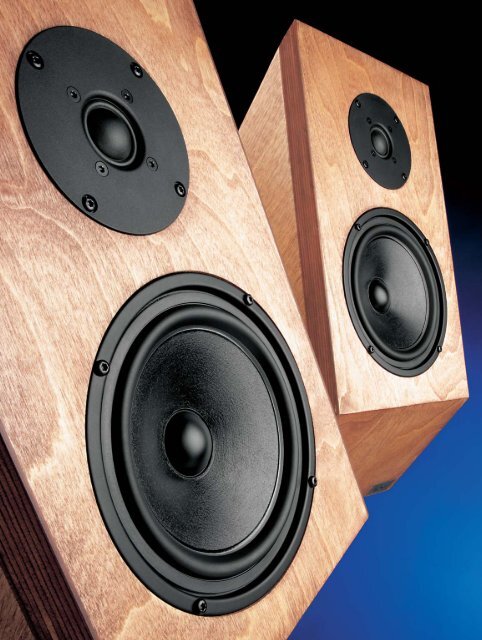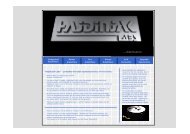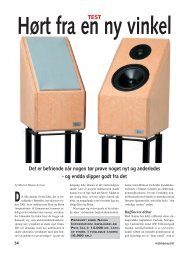review: hifi+, issue #44 - Kibri.dk
review: hifi+, issue #44 - Kibri.dk
review: hifi+, issue #44 - Kibri.dk
You also want an ePaper? Increase the reach of your titles
YUMPU automatically turns print PDFs into web optimized ePapers that Google loves.
EQUIPMENT REVIEW<br />
The kibri Naima<br />
Loudspeakers<br />
by Jason Hector<br />
As the resident omni user and supporter<br />
on the HiFi+ payroll I guess it was<br />
inevitable that I would get to <strong>review</strong><br />
the kibri Naima speakers. Hailing from<br />
Denmark kibri, like Shahinian, Duevel<br />
and others, are firm believers that<br />
speakers should try to mimic the natural<br />
dispersion of real sounds. They are<br />
preaching to the converted as far as<br />
this listener is concerned but many<br />
will rightly question the theory. Just as<br />
I did in the Shahinian Obelisk and<br />
Duevel Bella Luna <strong>review</strong>s, I will avoid<br />
commenting on this whole <strong>issue</strong> as I<br />
simply do not feel qualified to offer a<br />
cogent analysis or opinion. What I do<br />
know from significant experience over<br />
the last eight or so years, with four<br />
different brands of semi or pseudo-omni<br />
speaker in my and other systems is that a<br />
well executed pseudo-omni can sound<br />
very real and natural and can bring a<br />
performance into your listening room in<br />
a way that eludes most conventional,<br />
direct radiating speakers, at least to<br />
these ears. Whether the result with this<br />
category of speakers is strictly accurate<br />
could be debated but when it sounds so<br />
good I tend not to question too deeply.<br />
The kibri Naima’s are certainly capable<br />
of producing the beguiling qualities of<br />
the better omni’s and allied to their<br />
excellent timing and tonal qualities<br />
they are another pseudo-omni winner.<br />
The Naimas become a pseudo omni<br />
in the same way that the Heed Envoys<br />
and some of the Shahinians do, by<br />
mounting their drive units on a baffle<br />
that is reclined at approximately 45<br />
degrees to the vertical. This rakish angle<br />
goes far beyond the sort of sloping<br />
baffles seen to achieve driver time<br />
alignment on numerous other speakers.<br />
While the Naima design overlaps with<br />
the Shahinian ethos in many ways they<br />
are still a unique speaker. In much the<br />
same way that Heed have admired<br />
Shahinians and made their own take on<br />
the theory, so have kibri. But the best<br />
thing about the Naima’s is their price<br />
of around £1450 a pair once a UK<br />
distributor can be found. This price<br />
handily places them into a market sector<br />
currently bereft of competing pseudoomnis.<br />
Once you heft the cabinet,<br />
admire the fit, finish and material<br />
choice and then get a listen you<br />
quickly realise that this very<br />
attractive price is reinforced by<br />
the sound quality.<br />
Driver compliment of<br />
the Naima is pretty standard<br />
with a 170mm coated-paper<br />
bass-mid unit which is rear<br />
ventilated behind the spider<br />
and partially chosen for<br />
it’s high power handling<br />
with low total harmonic<br />
distortion (THD).<br />
The tweeter is a 27mm<br />
fabric dome with<br />
an acoustically<br />
damped rear<br />
chamber. Like the bass<br />
unit it has low THD and<br />
according to kibri both drivers release<br />
extraneous energy very quickly. This<br />
concern with the handling of energy is a<br />
key design criterion. The company have<br />
obviously invested significant thought<br />
into the way that the speaker handles<br />
pulses of sound and how the speaker<br />
components deal with unwanted energy<br />
and vibrations. It is no surprise that the<br />
reason they have eschewed the<br />
perennial MDF, turning instead to ply, is<br />
because they believe it handles energy<br />
better; to paraphrase the designer, the<br />
energy is removed from the driver and<br />
the baffle that bit faster and without out<br />
of phase vibration which can smear<br />
the sound. Like the ply Shahinians the<br />
corners of the cabinets are cut off to<br />
reveal the material.<br />
The average impedance of the<br />
speaker is 7 Ohms and the minimum<br />
impedance occurs at<br />
approximately 50Hz and is<br />
close to 5 Ohms. While that<br />
sounds pretty benign I<br />
think this impedance<br />
could be a bit reactive<br />
and combine this<br />
with a sensitivity of<br />
88dB and you have a<br />
speaker that is unsuitable<br />
for either cheaper valve<br />
amplifiers or poorly damped<br />
solid state. The speakers<br />
absolutely thrived on the<br />
control offered by my usual<br />
Dynavector power amplifier and<br />
they have enough quality to<br />
benefit from high performance<br />
upstream components. The<br />
crossover used in the Naima has<br />
been kept to six pair matched<br />
components, which are hardwired by<br />
hand. It is clear from the accompanying<br />
literature and correspondence that<br />
kibri have tried a number of different<br />
approaches to the crossover in their<br />
speakers and have traded off some<br />
smoothness of response for a more<br />
direct and agile sound. They claim<br />
that complex impedance corrected<br />
57
EQUIPMENT REVIEW<br />
crossovers sap some of the excitement<br />
and life from the sound and they do this<br />
by “slowing transient attack”, an opinion<br />
I have sympathy with, preferring lively<br />
albeit compromised speakers to ruler<br />
flat and dull alternatives.<br />
The Naima’s share venting duties<br />
across two ports which are mounted<br />
on the rear of the cabinets. According<br />
to kibri the Naima’s “are tuned to something<br />
between a sealed and a ported<br />
type. Their total "Q" is lower than<br />
usual with this kind of design, but sure<br />
contributes to its quick and agile style.”<br />
(sic.) Well, I can agree that the<br />
kibri’s are a quick and agile<br />
design, and the ports did<br />
not have any significantly<br />
negative affect on the<br />
sound. When positioned<br />
correctly, the ports did<br />
not seem to be asked<br />
to work as hard as<br />
those on other<br />
speakers of this<br />
size that try to go<br />
deeper with a<br />
similar driver and<br />
cabinet size. The<br />
Naima was capable of<br />
producing some good<br />
bass without boom or<br />
overhang and while they don’t<br />
plumb the depths, the presence region<br />
above 50Hz is strong and with their<br />
transient abilities the Naima’s will sound<br />
like they go deeper than they do; just<br />
don’t expect to hear all the pipes of a<br />
large organ. Overall the Naimas were<br />
pretty relaxed about room placement<br />
and require about 12 inches of space<br />
behind them. In my room some toe-in<br />
allowed the ports to breathe but they<br />
were close to energising a room mode<br />
(noticeable with certain tracks and<br />
higher volume) and some extra care<br />
with placement was necessary to<br />
ameliorate this tendency. Trying them<br />
with a significantly lower powered<br />
integrated amplifier did reveal how<br />
much they benefit from a bit of power<br />
and this led me to question the reactivity<br />
58<br />
of that impedance. By driving them<br />
with reduced power (actually transient<br />
current delivery) the speakers lost some<br />
of their incisiveness and as you might<br />
guess, the bass started to wallow a little.<br />
This isn’t a real <strong>issue</strong> provided you<br />
choose your amplification with care.<br />
Anything from the cheap but strong<br />
Rotel RA1062 upwards would be fine<br />
in most applications, and quality is<br />
still preferred over quantity.<br />
The one fly in the ointment is the<br />
look of the speakers on their manufacturer-preferred<br />
stands. The speakers<br />
themselves won’t<br />
be winning many<br />
beauty pageants, the<br />
murky brown finish<br />
undermining the excellent<br />
quality of the fit and materials.<br />
At least the slanting baffle has the<br />
effect of reducing the perceived size<br />
of the speaker. But place them on the<br />
open frame, square section stands and<br />
you have some visual synergy – the<br />
combination looks worse than the sum<br />
of its parts. I exaggerate slightly but the<br />
problem for kibri is that I am not sure<br />
that any standard stand design will look<br />
much better (the obvious solution is<br />
to make them a floorstander but I am<br />
guessing the price would then have<br />
to increase) and while they aren’t the<br />
prettiest solution, the stands provide<br />
good support and a solid installation.<br />
With this in mind I stuck with them for<br />
the <strong>review</strong> period in an effort to create<br />
the sound intended by the designers,<br />
averted my eyes and just enjoyed the<br />
sound.<br />
The Naima was good at letting you<br />
know when a piece of music was<br />
building in excitement and tension.<br />
They allow music to progress and<br />
develop and they achieve this by<br />
exhibiting commendable timing right<br />
across the frequency range and by being<br />
surprisingly consistent with level. I found<br />
the Naimas were particularly successful<br />
at communicating music when played<br />
quietly. Unlike many speakers there is<br />
no threshold above which they work.<br />
They easily retain the relative<br />
dynamics of a recording so that<br />
when the volume is reduced<br />
they still sound believable.<br />
They are not a rushed<br />
sounding speaker;<br />
instead they follow<br />
the musical flow.<br />
Even playing<br />
my timing<br />
torture tracks<br />
did not unduly<br />
phase the<br />
Naimas. A<br />
good example<br />
is the Home<br />
Burns album by<br />
Orange Can which has a<br />
wonderfully retro feel and<br />
builds and builds in complexity,<br />
from various simple motifs played on<br />
bass guitar. As the track evolves so to<br />
does the rhythm and the bassist weaves<br />
in more complexity around some<br />
repeating themes played on the electric<br />
guitar and delivered by the vocalist<br />
expanding the range and varying the<br />
pace. This can all fall apart and sound<br />
frankly boring on a poorly timing system.<br />
No problem with the Naima; at no<br />
time were you left in any doubt about<br />
the way the group of musicians was<br />
playing together. This was true
EQUIPMENT REVIEW<br />
across the musical range, from a simple<br />
clapped rhythm on Seth Lakeman’s Kitty<br />
Jay album to the complex intertwined<br />
melodies of larger pieces.<br />
Large scale orchestral was<br />
particularly convincing because the<br />
speakers, like the other good pseudoomnis,<br />
are capable of plausible scale.<br />
They don’t image in a holographic way<br />
(set against this is the lack of a sweet<br />
spot and the ability to enjoy these<br />
speakers way off axis) but they do<br />
present the performance in a natural<br />
sounding acoustic. It is very easy to<br />
close your eyes and feel that you have<br />
entered the hall in which the music was<br />
recorded with the orchestra arrayed in<br />
front of you in a palpable fashion. So<br />
while individual instruments and even<br />
groups of instruments are amorphous<br />
in the soundstage it is clear how big<br />
a sound they produce. I am trying to<br />
expand my classical music appreciation<br />
and have been exploring choral works.<br />
Again the Naimas are excellent at<br />
scaling a soloist relative to the choir<br />
itself (Beethoven’s Symphony<br />
Number 9 SXL6233 being a prime<br />
example) and retaining the sense<br />
of space between them. Returning<br />
to the Seth Lakeman for a totally<br />
different acoustic environment and<br />
the small intimate domestic spaces<br />
this album was recorded in are just as<br />
obvious, you are moved a lot closer to<br />
the performers (from the concert hall<br />
into the pub in most cases) but the<br />
relative scale of the people and their<br />
instruments in the space is well rendered<br />
and believable.<br />
I have already admired the Naima’s<br />
abilities to reproduce scale but they also<br />
demonstrate fine tonality and this allows<br />
acoustic music to sound very authentic.<br />
Rise times are pretty fast and decays are<br />
as expected with some truncation, but<br />
the timbre is as good as I have heard<br />
at this price. Different instruments are<br />
obvious in their construction, material<br />
and operation, while smaller scale<br />
transients like plucked acoustic guitar<br />
strings on the wonderful Opus 3 Eric<br />
Bibb Spirit and the Blues recording<br />
sounded real, with the solidity and<br />
tone of the guitar’s body behind them.<br />
With this recording we also have more<br />
evidence of the Naima’s ability to bring<br />
a performance to you, with Bibb and<br />
the band, who are asked to contribute<br />
instrumental and vocal accompaniment,<br />
arrayed around and behind the speakers<br />
in a very credible fashion. Commercial<br />
recordings, like the Kaiser Chiefs<br />
Employment, have their production<br />
failings and variable recording quality<br />
exposed, but when the band have<br />
managed to create a real hook like the<br />
song ‘I predict a riot’<br />
(where there<br />
is a wonderful driving beat which<br />
merges well across the verses into the<br />
chorus of the song) the Naima’s produce<br />
entertainment by propelling the rhythms<br />
into the room and grabbing your<br />
attention in the visceral way the band<br />
originally intended. Playing better<br />
recorded music reveals one of their few<br />
failings, a clouding or lack of absolute<br />
resolution and transparency. While this is<br />
most noticeable in the upper midrange<br />
it is not obvious in isolation, but<br />
comparing to a better (and significantly<br />
more costly) speaker or playing a piece<br />
with a really dense sound, some detail is<br />
lost while some instruments or note<br />
sequences remain unresolved. This fault<br />
is not as bad as it sounds if you are<br />
somebody who prefers to listen to music<br />
in the round, absorbing the whole rather<br />
than trying to dissect individual parts.<br />
The treble can sound curtailed in level<br />
compared to direct radiating speakers<br />
but this is more a function of their<br />
pseudo-omni operation than a real<br />
dip in response or treble energy. Not<br />
surprisingly, considering their country<br />
of origin, the Naimas tonal balance will<br />
suit livelier, Scandinavian style rooms to<br />
overstuffed Victoriana.<br />
Overall these speakers like all others<br />
at this price are a mixed bag with some<br />
fantastic strengths: their portrayal of<br />
space, scale and rhythms and their<br />
relative room friendliness. But they also<br />
have some failings in resolution and<br />
physical looks. After spending significant<br />
time with them as my main speakers<br />
and really exploring their limitations I<br />
believe that the strengths far outweigh<br />
the negatives and I whole-heartedly<br />
recommend you try to audition these<br />
speakers, especially if you tend to<br />
listen quietly.<br />
TECHNICAL SPECIFICATIONS<br />
Type:<br />
Two-way pseudo-omni<br />
Overall impedance: 7.2 Ohm, 5.1 Ohm minimum<br />
Sensitivity: 88dB/W/m<br />
Dimensions (WxHxD): 250 x 420 x 285mm<br />
Weight: 7.2kg.<br />
Finishes: Three different stains<br />
available<br />
Prices –<br />
Speakers: £1450 (Expected)<br />
Stands: £100<br />
Grilles:<br />
POA<br />
Manufacturer:<br />
kibri<br />
Net: www.kibri.<strong>dk</strong><br />
59




